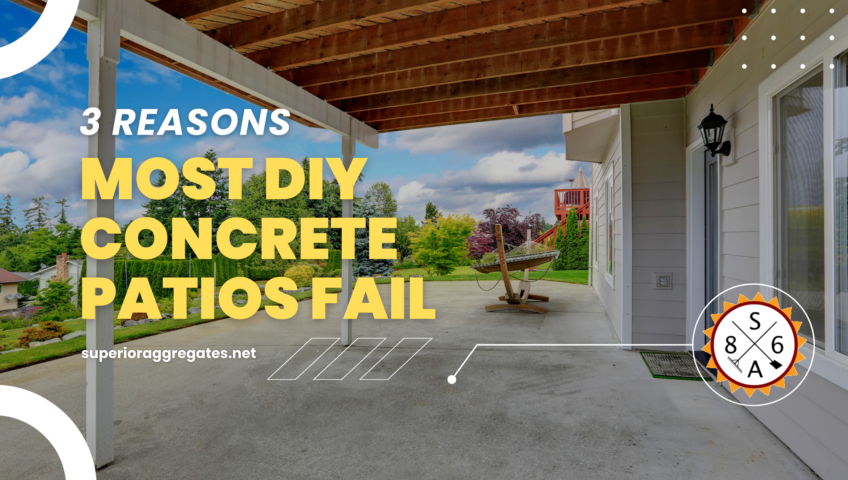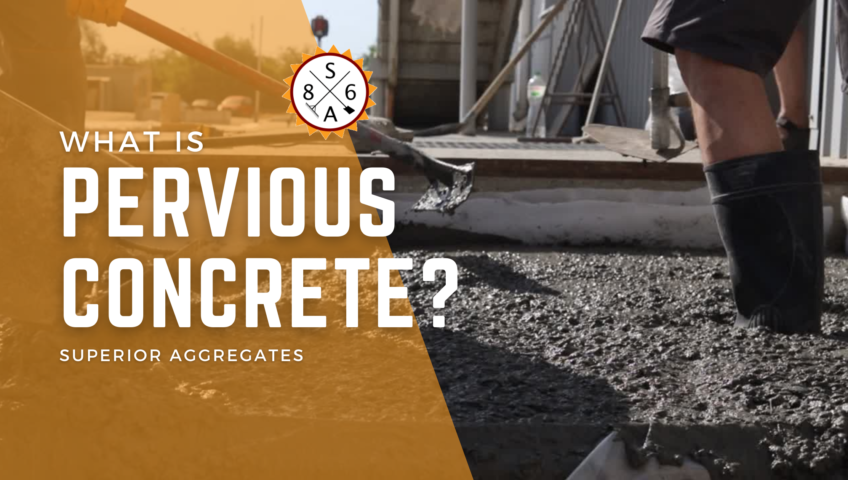
3 Reasons Most DIY Concrete Patios Fail
Tips from a Concrete Company to Set Your Patio Up for Success!
Concrete patios are becoming more of a trend and it’s not difficult to see why – they’re sturdy, they’re long-lasting, and they look amazing! But to have a concrete patio that’s sure to be the talk of the neighborhood, you’ll have to keep three important factors in mind.
If a concrete patio isn’t set correctly, it could cause dilapidations over time, which could potentially be dangerous. Make sure your patio is safe – don’t take shortcuts and refer to our additional concrete tips and tricks for more assistance.
From our concrete company to your home, follow along to create a concrete patio that avoids these common mistakes!
“Make sure your patio is safe”
Reason #1: No Concrete Form Is Built
In order to make sure your patio is stable and won’t crack/crumble over time, it is integral to have a concrete form. A concrete form works to keep your concrete mixture in place while it dries. When you originally mix your concrete, it will be more of a liquid (similar to a peanut butter texture) that can ooze and spill easily.
That’s why a form is so important, in order to keep your concrete in place while it hardens. Once it is set, it will become stiff, and you will be able to remove the concrete form as you wish. Be sure to allow 24-48 hours for your concrete to dry, depending on the type of mixture you used. You should be able to find this information in the directions located on the container.
“A concrete form works to keep your concrete mixture in place while it dries.”
Reason #2: Concrete Form or Template Isn’t Level
Because you’re going through the process of creating your gorgeous new patio, of course you want it to look its best! That’s why it’s so important to make sure before pouring your concrete that the form or template you’re using is level. If not, it could lead to bubbles, cracks, and splits within your new patio – which, surely, isn’t the look you’re going for.
This can sometimes be tricky to determine when working on uneven terrain, so it may be helpful for you to purchase a leveler, just to be completely sure that your form or template is level. This will ensure that your new concrete patio is smooth and seamless!
“Make sure before pouring your concrete that the form or template you’re using is level.”
Reason #3: Measurements are Rushed
As previously mentioned, it is extremely important to take your time when pouring concrete. As a concrete company ourselves, we wholeheartedly understand the intricacies that come with this process. Measurements are one of the very first things you should do before even thinking about leveling, mixing, or pouring your concrete.
If your measurements are rushed, there’s a higher chance they won’t be exact – which could lead to uneven forms, crooked templates, and an overall unideal outcome of your concrete patio. One of the biggest pieces of advice we can give you is to take your time to make sure the measurements are exact – from there, everything else should go smoothly!
“It is extremely important to take your time when pouring concrete.”
Contact us for more assistance
As your trusted concrete company, we are here to help you with whatever project you may be working on. For more tips, tricks, and advice, don’t hesitate to contact our experienced team members!
Tips from a Concrete Company to Set Your Patio Up for Success!
Concrete patios are becoming more of a trend and it’s not difficult to see why – they’re sturdy, they’re long-lasting, and they look amazing! But to have a concrete patio that’s sure to be the talk of the neighborhood, you’ll have to keep three important factors in mind.
If a concrete patio isn’t set correctly, it could cause dilapidations over time, which could potentially be dangerous. Make sure your patio is safe – don’t take shortcuts and refer to our additional concrete tips and tricks for more assistance.
From our concrete company to your home, follow along to create a concrete patio that avoids these common mistakes!
“Make sure your patio is safe”
Reason #1: No Concrete Form Is Built
In order to make sure your patio is stable and won’t crack/crumble over time, it is integral to have a concrete form. A concrete form works to keep your concrete mixture in place while it dries. When you originally mix your concrete, it will be more of a liquid (similar to a peanut butter texture) that can ooze and spill easily.
That’s why a form is so important, in order to keep your concrete in place while it hardens. Once it is set, it will become stiff, and you will be able to remove the concrete form as you wish. Be sure to allow 24-48 hours for your concrete to dry, depending on the type of mixture you used. You should be able to find this information in the directions located on the container.
“A concrete form works to keep your concrete mixture in place while it dries.”
Reason #2: Concrete Form or Template Isn’t Level
Because you’re going through the process of creating your gorgeous new patio, of course you want it to look its best! That’s why it’s so important to make sure before pouring your concrete that the form or template you’re using is level. If not, it could lead to bubbles, cracks, and splits within your new patio – which, surely, isn’t the look you’re going for.
This can sometimes be tricky to determine when working on uneven terrain, so it may be helpful for you to purchase a leveler, just to be completely sure that your form or template is level. This will ensure that your new concrete patio is smooth and seamless!
“Make sure before pouring your concrete that the form or template you’re using is level.”
Reason #3: Measurements are Rushed
As previously mentioned, it is extremely important to take your time when pouring concrete. As a concrete company ourselves, we wholeheartedly understand the intricacies that come with this process. Measurements are one of the very first things you should do before even thinking about leveling, mixing, or pouring your concrete.
If your measurements are rushed, there’s a higher chance they won’t be exact – which could lead to uneven forms, crooked templates, and an overall unideal outcome of your concrete patio. One of the biggest pieces of advice we can give you is to take your time to make sure the measurements are exact – from there, everything else should go smoothly!
“It is extremely important to take your time when pouring concrete.”
Contact us for more assistance
As your trusted concrete company, we are here to help you with whatever project you may be working on. For more tips, tricks, and advice, don’t hesitate to contact our experienced team members!

